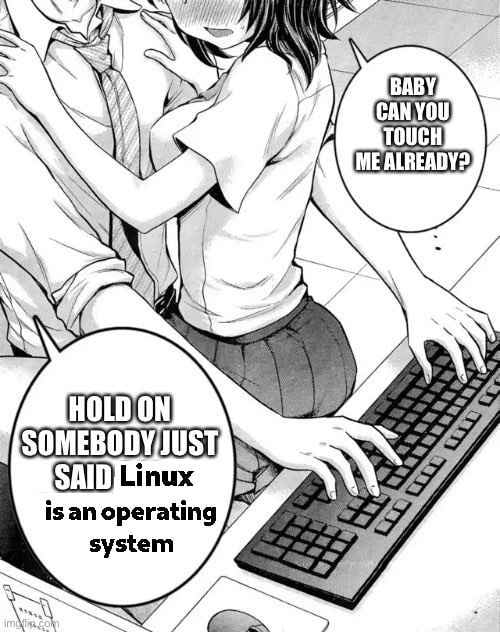I’m on windows 10. And they were right that it was the last version of windows I’ll ever need. I only change OS when I update my hardware. So next hw refresh, I’m going to Linux.
welcome
I will be happy to make the switch.
we all here happy to help you can ask me personally and i will help if i could so which distro are you trying first
I’ve used Mint, Ubuntu, CentOS and Kali here and there. Never on my personal computer though. May go with one of those, but I see some other newcomers that I might try. I appreciate the offer to help.
mostly debian so there won’t be big diffrence
Just switched from windows to arch with KDE Plasma on my laptop and I have been experiencing so much joy playing with all the wonderful FOSS I never even knew about
My Surface Pro 7 was perma nagging me about going to W11. Screw it, just installed LMDE 2 days ago, chose Mint Debian Edition as I use it on my desktop for the last 13 months.
So glad I switched to Linux a year ago, so much bs from Microsoft for exactly this and it was too much bs.
deleted by creator
@mugdad1 @gandalf_der_12te,
at the very least, it seems to me that the height of the picture in header is too high. I think that height enough:Getting an SSL protocol error on that link.
deleted by creator
Sure it can’t be uninstalled, but that’s no big deal. Just go to Settings and turn it off.
Of course, software needs to update, so it might get turned back on occasionally. Just go turn it off again.
And all the other stuff you turn off. Every time.
Can anyone recommend a very beginner friendly Linux OS for someone who only knows what Linux is but doesn’t have experience with it and has never used anything but windows? Even Apple’s OS is confusing to me. But windows is trying to force this most recent terrible update every time we turn on the computer, and I’ve had enough.
(I told my husband about all the helpful comments and he sent me this, thinking that’s what everyone was explaining to me. I told him no, I know Linux isn’t an OS, I just didn’t know the OS’s are called distros. Cue the most confused face I’ve ever seen. He’s usually more tech savvy than I am, so I got an ego boost explaining it to him. Thanks everyone!)

@PagingDoctorLove @mugdad1 I’m thinking Ubuntu, Mint, or MX Linux. But any Linux will be at least a little different from Windows. It’s not hard to get used to, and it’s worth it.
Endeavour OS. It may be a bit more hands on than something like Ubuntu/Fedora but there are ways less abstractions, better document and community support that makes it simpler over all.
Pick up a note-taking application like Joplin or something and write down solutions to problems and you’ll be fine.
I’d recommend against Ubuntu/Fedora/Mint etc. tbh, they are simpler on the surface but there are no ing parts that make it more complex when things break.
Play around with distrobox and docker too, that makes a lot of stuff easier.
I like Kubuntu tbh
I didn’t like Mint all that much.
If you have an old laptop you can try a few out and see what works, they’ll run faster than windows. If you’re on windows you might have access to Hyper-V Virtual Machine and then you can just run some Linux Distros in a virtual machine to see if they’re nice. You can even try moving some files into the VM and see if you can still work with them after a migration from windows.
I switched a few years ago. I’ve been using windows for over 30 years. They changed a bunch of random shit I had used in the past. I figured I’d give it a shot.
I never went back. I’m not a coder. I don’t even like tech very much. I’ve been really happy with Ubuntu for years.
I wanted something that just worked. It has.
The Steam Deck was the reason I changed. Used the Deck as my only PC for a couple of months and liked the experience so I changed.
I’ve had OpenSUSE on my PC for over a year now and really like it… But I’ll be honest, the move and troubleshooting problems for setup was a pain in the ass. But it’s stable and steady since I’ve gotten over setup pains.
I installed Pop!_OS on a Thinkpad and made it my main work computer. It is the most boring computing experience ever. Nothing ever breaks. It just works.
I’m at about 19 years since switching - MS reaffirms my decision for me each and every year.
If there’s any new Lemmy users here, coming from Reddit (feel like I’m opening a seance), and if you’re wondering what else you might decide to change during this era of change -
Try Linux! It’s easy now, and frankly just better :)
Yes, I’m new to Lemmy, ex-Reddit, and now I’m looking at what else I can do. I ran Linux Mint on an old laptop for many years, but that was when I was still working and I also had a company laptop on Windows if I needed it. So now I’m retired and currently I only have a refurbished Lenovo with Win 10, which goes out of support soon. I suppose I could do dual boot on that machine, but I’d rather have Windows in a VM for the rare occasions when I can’t get something to run in Wine. I have no idea where I’d buy a copy of Win 11, but presumably Microsoft have a store.
Linux!? But I heard that’s nerd stuff and I want to play all the latest video games!?
If steam deck runs it, linux runs it.
They’re all steamos
This year totally is the year of Linux, guys!
Trust me!
The only way Linux ever becomes viable for the mainstream is when there is a single distribution that covers every feature and is as streamlined and user friendly as possible.
- No command lines ever for anything
- huge software compatibility
- hardware compatibility of the newest and oldest of hardware
- easy troubleshooting even your nan can follow
- and most of all: every Linux user agrees it is the best Linux distribution (unless you are into niche stuff)
So until even you guys can agree on one distribution being the best, it will not be the year of the Linux ever.–
Or macOS
idont think so mac is closed source
That is true but it is still Unix based and doesn’t come with candy crush preinstalled
To be real Linux is far from ready to be an all in all viable alternative to windows.
The fact that it has a hundred desktops. An absence of major software like ms office. Adobe and autodesk suites, and not being able to avoid the command line when shit hits the fan. Will make users choose to purchase new hardware rather than make the jump.
I bet Linux will make a 2% after win 10 end of support.
It really depends on your use-case, your criticism is valid though. In general it would be way better for new users to not learn about it as something that gets slapped onto a Windows machine, but on fair grounds for comparison (meaning on a machine from hardware vendors like System76, Tuxedo, Slimbook etc).
For Software it really is a hen-and-egg problem. Big companies won’t support Linux until enough people are there, and enough people won’t come until known software is available. This however changes gradually; The Software Store is receiving payment features in the future (almost any distro uses Flatpaks in the background), so there will be more viable paths to monetize your software product for companies. Meanwhile the amount of users rises more and more for years now thanks to 1. Valves push with SteamOS + Hardware and 2. India and China who got comparably high Linux userbases (I think in India it’s 13% of all desktop PCs).
So yeah, not there yet. But not “far from ready”, really. It just needs some software improvements that are in the works, and for the device vendors to become more known.
Wait, what distros use flatpak by default?
I don’t even know where to begin… Fedora, Pop!_OS, KDE Neon, elementary OS, Tuxedo OS, Slimbook OS, any Ubuntu flavour that doesn’t default to Snap, Zorin, Nobara, Mint… and any distro that comes with KDE that doesn’t activate Flathub by default (e.g. OpenSuse) got the “Add Flathub” button built-in right in Discovery.
If you want your app to be accessible to as many distros as possible while retaining control over its distribution, Flatpak (and unfortunately Snap) really is the primary way to do so. Once KDE e.V. and the Gnome Foundation finish their efforts to support payments and ownership handling it’s also the golden way for any developer who wishes to make a living with their craft.
Oh lol, that is a lot. I’ve only used ubuntu, Debian, Fedora (i3 spin, which I believe had only dnf as a package manager), endeavouros, arch and researched nixos (which I’m definitely trying next) so I’ve never actually had flatpak preinstalled to my knowledge.
What most Linux advocates hate to admit is that the abundance of distributions discourages software makers from supporting Linux. Because then they will have to deal with bugs specific to each distribution, desktop environment, window manager, x.org or Wayland, and thousands of other variables. Imagine having to spin up a different virtual environment for each use case. It’s a nightmare that isn’t worth it for them.
I don’t think that’s the main problem, as on the inside (meaning backends) most things are rather standardized (ignoring legacy stuff) and any distro not adhering to those modern standards can be - purely from an economic aspect, NOT a nerd or enthusiast aspect - safely ignored. I do concur that choice paralysis indeed is a problem though.
The modern stack is pretty straight-forward: Flatpak and Snap for distribution, GTK4 (opt. with or without libadwaita) or Qt6 for the UI, Gnome and KDE to take care for proper integration, and stuff like Wayland, Pipewire and the XDG specs to focus on in technical aspects. All the documents necessary to work on fully functioning apps to publish via both Flatpak and Snap are there (not saying everything is perfect, just that it’s properly working). Distro-specific bugs will also be either prevented by the new sandboxing or are to be fixed by the distro in 99% of all cases, not the app author. What’s really missing right now is a way to sell it through those hubs.
Eventually there’ll be sufficient pressure on all sides so common technical necessities will be defined that distros will have to adhere to if they want to receive app support (which is very much possible given the sandboxing around Flatpaks and Snaps). Until then every company keeps freely defining what they support. Right now they usually go two or three big ones, namely Ubuntu, RHEL+Fedora and perhaps SteamOS. Some also go for OpenSuse, probably because they use SLES for their own machines.
Meanwhile commercially developed distros - meaning stuff like Pop!_OS (System76 devices), SlimbookOS (Slimbook devices), Tuxedo OS (Tuxedo Computers) - all use Flatpaks, and as they all integrate it as intended apps work on them as they do on any other distro that uses the modern stack. So customers don’t have to think too much about it.
tl;dr… Don’t give new users too many options (avoids choice paralysis) but 1 or 2 modern ones or whatever a hardware vendor offers, and don’t expect developers to target distros that do not want to fully support either Flatpaks or Snaps. Then we’re already on a good way.
@Natanox @mtchristo
>Flatpak and Snap for distribution, GTK4 (opt. with or without libadwaita) or Qt6 for the UI, Gnome and KDE to take care for proper integration, and stuff like Wayland, Pipewire
I do not have anything of this in my system and will not install any app that requires to support all of this.
Flatpak even cannot work without namespaces (which is not enabled in kernel defconfig). If you want to make flatpak default option to distribute apps, first make sure it does not require enabling some (possibly insecure) kernel configurations and work on default kernel
Wayland (in current implementation) is error. Flatpak/snap is error.
Before all of this, all we need to make app work is some x11 libraries, so app can bundle it’s needed portable toolkit and run without any additional requirements. Now we cannot just provide wayland-client, because app cannot draw with it. It needs opengl, which needs many libraries, which… cannot be provided in compatible way, so you need container bullshit that runs other distro inside… only to run some graphical app that draws few buttons…
Really, i’ll prefer using windows, not this bullshit.
Now flatpak causes people ignoring new glibc compatibility bugs, so it soon will be impossible to build portable binary for glibc systems… Even now Portable Executable (windows exe) is most portable way to distribute software for linux, because wine gives compatibilty that glibc cannot (or jusn do not want). And sometimes wine even have less memory overhead than flatpak/snapI do not have anything of this in my system and will not install any app that requires to support all of this.
What are you using, a potato? Any modern distro comes with those. Without GTK4 and Qt6 barely anything even runs, lol.
I mean, you can reject literally everything of this new technology stack, but that doesn’t change the fact it’s things are working now. If you stay with old tech don’t be surprised if things stop working though, the world will move even if you prefer to stand still. However if you want to be taken serious in your criticism please inform yourself on what you’re criticize. Neither Flatpak nor Snap run “another distro inside”. What you’re talking about is stuff like Docker or Distrobox. Those are neither the default on user systems nor should they be, only very few distros aimed at enthusiasts and professionals ship them by default.
There are also multiple ways to ship portable apps, the best known of them would be AppImage. That one simply isn’t recommendable due to a lack of maintenance and security issues (they simply don’t fix the libfuse2 issue).
It’s not like everything was great in ye’ olden days anyway. There literally are FOUR different backends for desktop notifications, Pulseaudio is a friggin’ trainwreck and don’t even get me started on Xorg configuration. Every desktop environment very much did their own thing and once you installed an app using f.e. GTK2 on a KDE3 system the whole thing looked like it recently insulted Mike Tyson since there was no proper config available / it lacked the icon theme / the font broke everything / it didn’t like your hairstyle. Likewise running older software more often than not was a real pain as they expected an environment with obsolete libraries etc.
Like it or not, Flatpak and Snap already are the standard. So is Wayland (and it works like a charm by now), and Pipewire is a god damn godsend after meddling with Pulseaudio all those years. And from a developer’s perspective it’s so nice to have a controllable environment to work with, i.e. Flatpak and Snap. Of those two only Snap generates huge overheads btw, it’s a known problem with Canonicals approach (one of many). Still, technology like that is what Linux needs for the future.
But hey, ultimately Linux gives you the choice. If you want to stay in your niche I hope it suits you well.
However if you want to be taken serious in your criticism please inform yourself on what you’re criticize
they simply don’t fix the libfuse2 issue
Neither Flatpak nor Snap run “another distro inside”
The flatpak runtimes are huge and are another distro in practice, just check the contents of the gnome runtime and you will see it is another distro.
Flatpak also depends on namespaces which paranoid distros disable and cause issues. Which the person you responded to talked about it and you ignored all together lol
Fixed 3 years ago
This contradicts their own wiki. Type 2 AppImages do use libfuse2, which is the problem.
Flatpak also depends on namespaces which paranoid distros disable and cause issues. Which the person you responded to talked about it and you ignored all together lol
Because it makes absolutely no sense what he said. Even in the github thread you linked it is said that namespaces are enabled by default in the kernel nowadays, and any alternative would be more insecure. With the exception of Ubuntu (which uses Snaps) any major distro either comes with Flatpak already installed or the ability to do so with just 3 commands that do not change anything in the kernel. Like, he got it backwards: you have to disable namespaces (and by doing so break any non-legacy kind of virtualization or sandboxing) by default.
The flatpak runtimes are huge and are another distro in practice, just check the contents of the gnome runtime and you will see it is another distro.
I think our definitions vary. What I was thinking about when hearing “another distro” was stuff like Docker, where another kernel, package manager etc. gets loaded. Do you just talk about size?
It has a hundred desktops
Are you referring to distros? Just pick one that’s widely used and that’s it.
An absence of major software like ms office. Adobe and autodesk suites
You can use it online. Or, even better, use something like LibreOffice. For adobe and autodesk you’re SOL but that’s very intentional and it sucks. The only solution is a VM.
and not being able to avoid the command line when shit hits the fan.
I don’t really get this. You can’t avoid using cmd on windows either when shit goes wrong. There’s nothing strange there.










